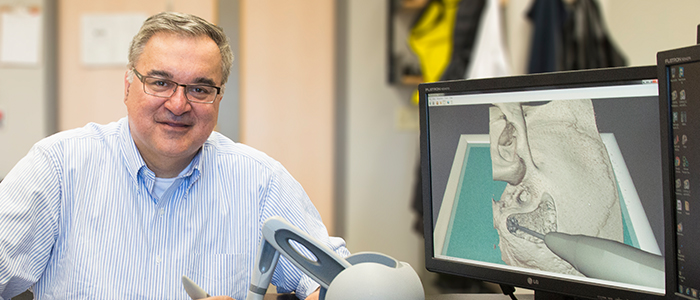The Entrepreneur

By Jennifer Parraga, BA'93
Trudging through snowy streets on cold, dark mornings, a young Hanif Ladak delivered newspapers to the residents of Brantford. As the sun began to rise and his bag lightened, he daydreamed about his next project.
In a few weeks, he’d have enough money saved to buy a new computer game, which he would intricately dissect with a goal of making it better. An entrepreneur in the making, Ladak was only 11 years old when he purchased his first computer, a Commodore 64. He began developing computer games, which he would sell for profit.
Ladak had been in Canada only a few years when he started delivering the daily newspaper. It was a job he gladly held for many years as it fed his entrepreneurial efforts. “I’m pretty sure I was the longest employed paper-boy,” he said with a chuckle.
Born in Mbale, Uganda, Ladak’s family was forced to leave under the regime of Idi Amin. They fled to Pakistan and lived in a compound for two years. Coming to Canada several years later had its challenges, but it gave the Ladak family new opportunities and, most importantly, a chance for Hanif and his siblings to attend school.
Being able to receive an education is an opportunity that Ladak has never taken for granted. By the time he was in Grade 11, Ladak had planned out his educational path. Excelling in math and the trades, such as electricity, Ladak focused his future on engineering.
Keeping in mind his parents’ hope that medicine could factor prominently in his future, Ladak explored any opportunities he could find related to biomedical engineering. With a teacher serving as his personal cheerleader, Ladak was able to secure scholarship support to pursue post-secondary education and his well-planned goals.
An undergraduate and master’s degree in engineering came first. A PhD followed. It was during his doctorate that Ladak’s research began to focus on measuring and modeling the mechanical behavior of the middle ear. “The ear has one of the most complex and intricate engineering systems,” Ladak said enthusiastically. “There’s so much we have learned and can continue to learn from it— it’s very rewarding.”
Ladak arrived at Western University in 1997, when he began an NSERC postdoctoral fellowship in the Imaging Research Labs at the Robarts Research Institute. He focused his research on the design and testing of medical image processing algorithms.
Today, the biomedical engineer is an associate professor, with joint appointments in Medical Biophysics and Otolaryngology – Head and Neck Surgery at Schulich Medicine & Dentistry and Electrical and Computer Engineering in the Faculty of Engineering. He teaches courses in image processing and basic circuit theory and electronics, and has designed a module for auditory biomechanics.
Ladak also supervises three master’s students, one PhD trainee and one postdoctoral fellow. He hopes to share his passion for biomedical engineering and entrepreneurship. “I like seeing my students fulfill their career goals,” he said. And so far, he’s had 100 per cent success with that. “All my students have been able to gain employment in their field or start a venture of their own.”
Ladak’s many teaching commitments and dedicated mentorship tell only half of his story, however. He has several successful ongoing research projects, and his entrepreneurial spirit hasn’t dampened with time. A number of his projects have translated into clinical applications and led to commercialization.
One such project is focused on software to support simulation training. An otoscopy simulator, which is used in developing the skill for diagnosing conditions such as ear infections, has been commercialized and is a cloud-based system that can be easily accessed. The student team behind this project won the grand prize for the Proteus Innovation Competition in 2016. Meanwhile, Ladak is also working on a virtual reality simulation system for myringotomy training.
Ladak has also partnered with MED-EL, a company that develops cochlear implants, on yet another project. “One of the challenges with cochlear implants is programming the implant after surgery,” explained Ladak. “We are using imaging to assist with development of programming methodology to optimize hearing outcomes." The University’s strength in Otolaryngology and imaging make it a natural leader in this research area.
The quiet and lonely streets of Brantford that once inspired Ladak’s creative and entrepreneurial spirit as a young boy have given way to jam-packed classrooms with students eager to learn, collaborative departments where communication is encouraged, and labs with no walls or boundaries. The result has been out-of-the-box translational research projects and new ventures that are helping to change the delivery of education and health care.








